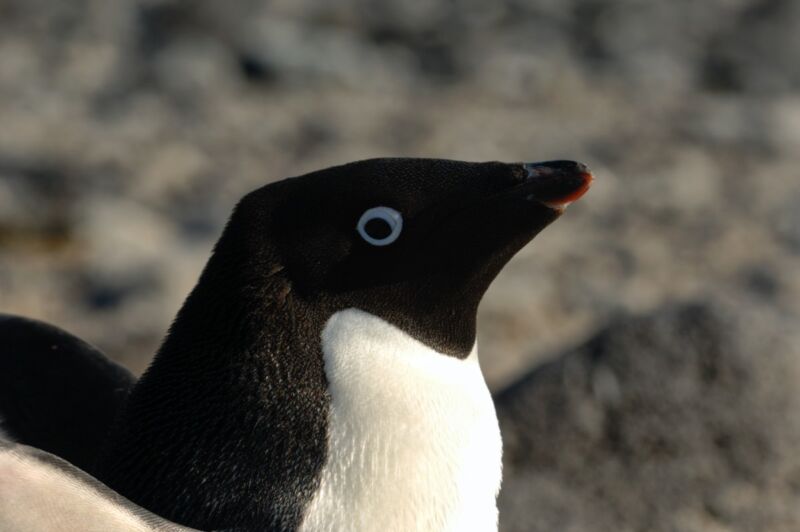
Nature is a brutal place, so during brooding, chinstrap and Adélie penguins are reluctant to leave their eggs unguarded in the nest—even to relieve themselves. But one also does not wish to sully the nest with feces. So instead, a brooding penguin will hunker down, point its rear end away from the nest, lift its tail, and let fly a projectile of poo—thereby ensuring both the safety of the eggs and the cleanliness of the nest.
Back in 2003, two intrepid physicists became fascinated by this behavior and were inspired to calculate the answer to a burning question: just how much pressure can those penguins generate to propel their feces away from the edge of their nests? Answer: about three times more pressure than a human could produce. That paper earned them a 2005 Ig Nobel Prize and lasting glory among those obsessed with pooping penguins. Now, a pair of a Japanese scientists has weighed in on the matter, calculating the projectile trajectory of expelled feces and recalculating the rectal pressure. These scientists reported on their findings in a draft paper they posted to the physics arXiv.
According to Victor Benno Meyer-Rochow of the Research Institute of Luminous Organisms in Japan, a co-author of the original 2003 paper, these fecal findings all started with an expedition he led to Antarctica. Although he was collecting samples of local marine worms and tiny terrestrial insects called springworms for further study, he also took copious photographs of the many penguins in the region, which he used in his lectures. During a seminar at Kitasato University in Japan, a young woman asked about a slide showing a penguin brooding on its nest, wondering about the white and pink lines radiating outward. She interpreted them as "decoration" and asked how the penguins made them.
"I explained that a penguin stands up, moves to the edge of its nest, turns around, lifts its tail, and then shoots from its rear, which leaves a 30-40 cm long streak of semi-liquid whitish stuff behind," Meyer-Rochow wrote in a 2019 blog post. "Everybody laughed—with the exception of the questioner. She got red in her face and quietly sat down." (The color of the feces depends on the penguin's diet: if primarily fish, the poop is white. If the penguin has been feasting on krill, the poop takes on a pinkish hue.)
-
An Adelie penguin turns an egg in the nest.
-
Diagram from the original 2003 paper detailing position of model penguin during defecation.
-
Ready, aim, fire! New configuration for a defecating penguin standing on a rock.
Meyer-Rochow maintains that it wasn't a stupid question, particularly since it prompted him to take a closer look at his slides, among which he found several photographs that captured penguins mid-poop. Measuring the lengths of the streaks fanning out from the nest was a simple-enough matter. Estimating the height above ground and aperture of the cloaca—the opening through which penguins defecate—was equally simple. He also determined the surface "stickiness" of penguin dung. With that information, Meyer-Rochow and his co-author, Jozsef Gal of Loránd Eötvös University in Hungary, were able to calculate the force that would be required to propel the poop 30-40 centimeters. Then they used that figure to estimate how much pressure penguins must exert to shoot their poo away from the nest.
The answer: internal penguin pressures can reach 10 to 60 kilopascal (0.1 to 0.6 atmospheres, or 600 grams per square centimeter), significantly higher than the pressure the average human can exert when defecating. Meyer-Rochow said the pressure was comparable to "at least one half of the pressure of our cars' tires," adding, "Not bad for a little fellow one third the size of a human." However, the study did not address why the streaks radiate out from the nest in all directions with no noticeable preference. Is this dependent on wind direction, or does a penguin somehow "choose" where to fling its feces? That remains an unresolved question.
New sh*t has come to light
In this latest paper, Hiroyuki Tajima of Kochi University and Fumiya Fujisawa of the Katsurahama Aquarium in Kochi, Japan, note that the original 2003 paper did not take the projectile trajectory of the penguin feces into account. Instead, it focused on a horizontal distance. Tajima and Fujisawa argue that the angle of ejection is not always horizontal, especially if the breeding environment is in a higher location—or if the penguin is standing on a rock while defecating, for instance.
Using Newton's equations, they calculated that the maximum flying distance of penguin poo is 1.34 meters, or 4.39 feet. Tajima and Fujisawa also revisited the question of the rectal pressure required to achieve such a trajectory and found it would be a bit higher than the original estimation. They noted, however, that their simplified equations did not account for the hydrodynamics of feces in the air and in the stomach, "which are left for future work."
As for why they chose to revisit the physics of pooping penguins, "These bombings sometimes embarrass keepers under breeding environments like an aquarium," the authors wrote. Thus, "It is practically important to know how far their faeceses [sic] reach from the origin. Such information would save keepers from the crisis. It would also be helpful for a newcomer guidance for keepers to avoid such an incident."
DOI: Polar Biology, 2003. 10.1007/s00300-003-0563-3 (About DOIs).
reader comments
99